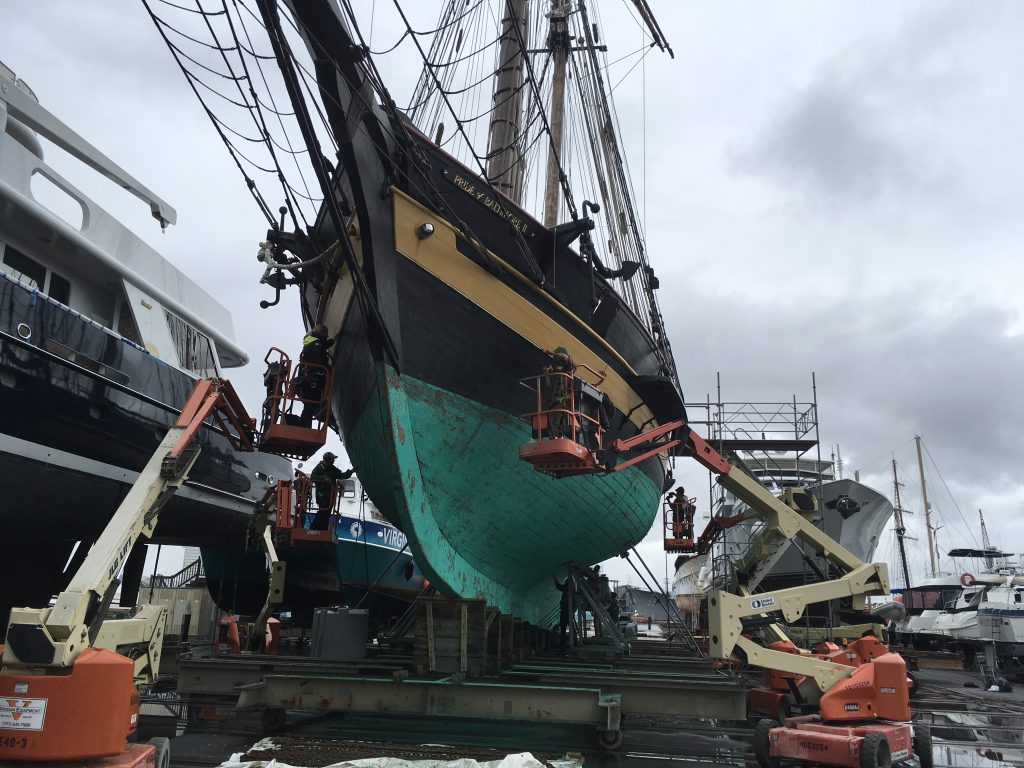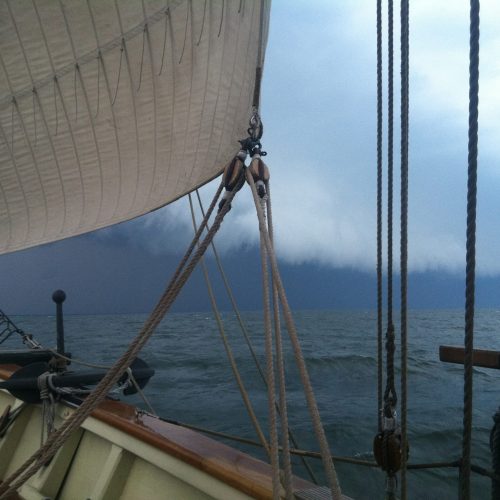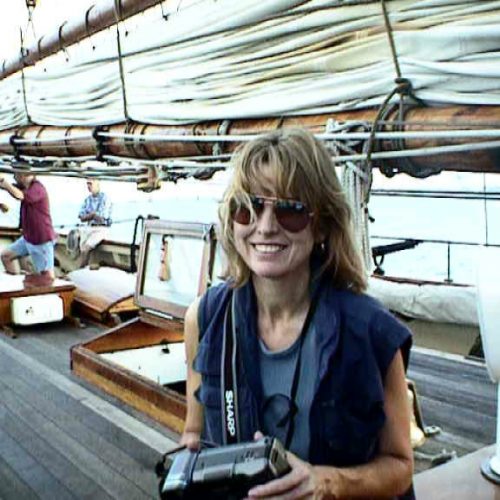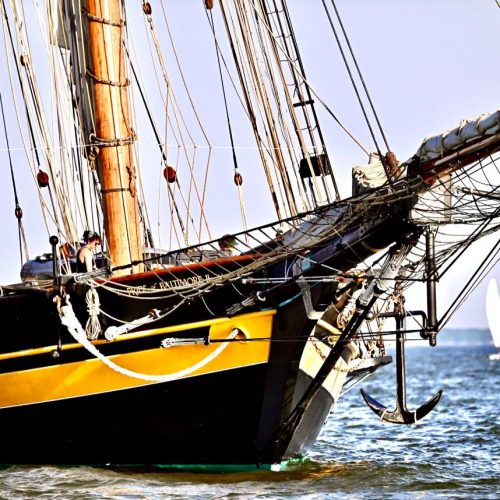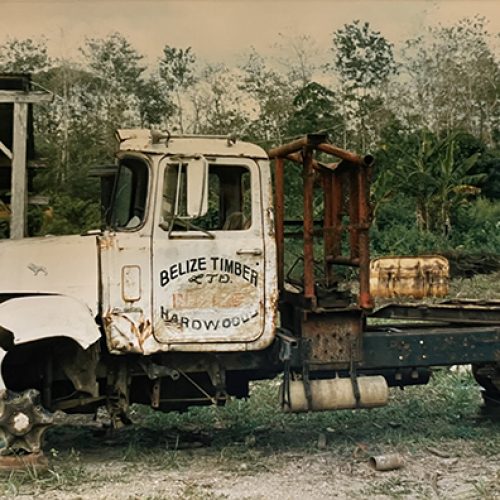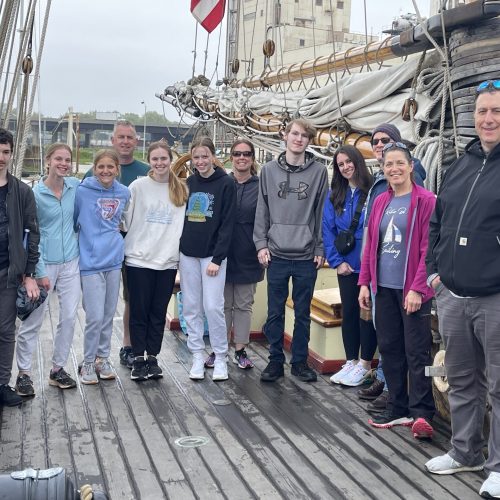Tuesday, November 7, 2017
Position: Ocean Marine Yacht Center in Portsmouth, VA
The view of a vessel out of the water has a surrealistic quality. What goes into dry-docking a sizable vessel like Pride of Baltimore II? A lot of preparation and some visual magic.
At Ocean Marine Yacht Center, the process of bringing a vessel out of (or into) the water is by elevator. The system is made up of a series of electrically powered wire-cable winches attached to a platform (four per side). The electric powered wire-cable winches need to remain precisely synchronized as they elevate the platform up and down so as to not distort the platform. Hence, the trademarked name of Syncrolift.
A vessel out of the water is no longer supported. Therefore, a mechanical support system needs to be assembled and placed upon the Syncrolift platform for the vessel to settle into as replacement for the stabilizing support of the water. This mechanism is called a cradle.
Making a cradle at Ocean Marine starts with joining sections of rolling carts to fit the length of the vessel’s hull. Upon this rolling cradle platform, wood blocking is set along the centerline to conform to the profile of the vessel’s keel. This profile is found in the design drawings of the vessel. On each side of the rolling cradle platform, additional wood blocking is set to receive steel bilge supports. The bilge supports have pads at the top for resting against the hull. These pads can swivel in order to land freely square to the hull, providing a spread surface of contact. Pride’s bilge supports are custom manufactured for her so that from the wood pads on the side of the cradle, a suitable load-bearing angle is formed leading up to the point of contact on the hull some distance to the side of the center of gravity.
This cradle assembly is rolled on to the elevator platform and lowered into the water to a depth clear of the vessel’s draft. The vessel is operated into a slip over the submerged platform. This maneuver must be timed to occur at slack current because the dry-docking slip is perpendicular to the current. High water slack is best because it allows for the greatest clearance between vessel and elevator platform to protect the cradle from being knocked by the hull during the time it takes to moor the vessel precisely over the rolling cradle assembly.
Divers are sent down with real-time communication devices so they can discuss with the dry-dock foreman the positioning of the vessel’s keel over the keel blocks, not only in terms of the centerline but also fore and aft positioning due to curve of the keel profile.
When the keel is aligned to the cradle, the elevator is lifted to a point where it is carrying about 20 tons of weight. Yes, the Syncrolift has weight sensors. When the divers confirm the alignment of the keel with the keel blocking, the elevator takes on more weight by raising to a point where maybe one third of the vessel’s weight is carried. At this point, the bilge supports are slid in from the side and make contact with the hull. The divers then work the bilge support pads against the hull using very large threaded screws. This is done to be sure that the total of eight bilge supports, four per side, are equally making contact with the hull.
Then more weight of the ship is taken by the elevator. An additional round of diver checking occurs. Meanwhile, a gangway from shore to ship is rigged to offload crew. When all personnel are off the vessel, the elevator platform is raised to ground level. The yard crew rig cross-chains between pairs of bilge supports to insure that no spreading will occur from the vibration of the rolling process.
The whole ship and cradle assembly is then rolled off of the elevator platform onto ground via a railway track ashore. Cleaning of the hull occurs right away. Meanwhile, crew can re-board and deal with details for the stay “on the hard” — shore power is rigged, preparations for cooling water for refrigeration begin, and ship’s cook, Phil, goes to cooking supper. When the cleaning of the hull is complete, the ship is shifted to the side via the rail grid so that the elevator platform can continue to be used for other vessel dry-docking evolutions. Some vessels are going back into the water after work is completed, some are being lifted for their own work. Each night the crew head to shore-accommodations after supper aboard. All meals are provided aboard.
A seemingly complex system that is actually fairly straightforward. The transition days from afloat to dry and from dry to afloat can be pretty busy, not just with the transitions of the vessel, but also with the transitions of living aboard, then living ashore, then returning to living aboard.
Signed,
Captain Jan C. Miles

